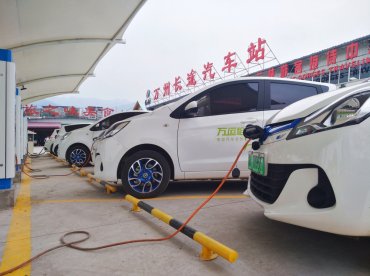
Global demand for automotive lubricants should continue to rise even as electric vehicles become more popular, an official from consultancy Frost & Sullivan said recently. Thats because the global vehicle parc will still be dominated by internal combustion engines despite quickly increasing sales of EVs.
In a new study, Frost & Sullivan concludes that total automotive engine oil demand will grow from 15.5 million metric tons in 2018 to 22 million tons in 2040 if global sales of EVs – including plug-in hybrids and vehicles powered purely by batteries – rise to 20 percent of all passenger car sales.

Photo: xujun/Shutterstock
Electric vehicles charging at a station in Chongqing, China. By 2040 Frost and Sullivan projects that electric vehicles will account for 32 million, or about 20 percent, of new car sales globally.
Under the same scenario, the firm estimates that demand for automotive greases will rise from 620,000 tons to 870,000 tons; that demand for what it calls automatic transmission fluid will jump from 1 million tons to 2.2 million tons; that demand for automotive gear oil will expand from 1.5 million tons to 1.7 million tons.
But impacts will vary significantly between different regions, it added, with trends being more pronounced in China and Japan, which are leading adopters of electric vehicle technology, compared with Australia, a world laggard.
Frost & Sullivans projections, provided to Lube Report in an interview, comprise lubricant demand for on-highway passenger and commercial vehicles, including light, medium and heavy trucks. It doesnt include off-road vehicles used on farms and mines.
Vijay Rao, automotive and transport research director at the Sydney office of Frost & Sullivan, explained that the main reason for resilience in its forecast of automotive lube demand is that it expects the global car parc will continue to be dominated by internal combustion engines.
There will still be so many cars on the road that use gasoline and diesel, so its not so much about new vehicle sales as it is about how many vehicles are on the road, said Rao.
In 2018, global sales of electric and plug-in hybrid passenger vehicles are expected to reach approximately 1.5 million units, Frost & Sullivan said. Plug-in hybrids, which have conventional engines (and need engine oil) as well as electric motors, account for about 70 percent of that, and pure electric about 30 percent. This proportion is set to change.
By 2040 the firm expects annual EV sales of 32 million, or about 20 percent of all new cars. Forty percent of those are expected to be plug-in hybrids and 60 percent pure electric. So we see that with a growth in plug-in hybrid, the engine oil market will still grow, Rao said. It will not fall all of a sudden: we still see a bigger market.
Shifting the car parc toward EVs depresses engine oil demand because BEVs – purely battery-powered vehicles – have no engine oil, and hybrids use less than cars running solely on internal combustion engines. Automatic transmission fluid demand will rise because EVs have automatic transmissions.
Gear oil volumes will remain stable because there will still be significant numbers of non-electric vehicles with manual transmissions, Rao said.
It wont go down, but it will almost remain stable because you will still have manual transmission vehicles on the road, said Rao.
And then theres grease. Grease is used in brake pads, wheels, gears and transmissions in a conventional-engined vehicle.
There are a lot of places where grease is used, so we do see the market expanding for grease, again not substantially, because going to electric the number of components requiring grease is reduced, said Rao. For example theres no need for lubricants for brake pads in an electric vehicle, as the electric motor acts as a brake.
Meanwhile, its worth noting that the shift to EVs will mostly be a trend for light-duty vehicles. Electric trucks are coming, too – Tesla, Daimler and Isuzu to name a few – but they lag. And, while trucks are less numerous than passenger vehicles, they presently account for about an equal share of the lubricant and grease market. Thats because the average passenger vehicle is a 1.4-liter engine, which requires about four liters of engine oil a year. By comparison, the average commercial vehicle, a seven-liter engine truck, will consume as much as 18 liters of engine oil a year.
Frost & Sullivans studies also included more conservative and more optimistic scenarios. For example, if the proportion of electric and plug-in hybrids only reaches 10 percent of new vehicle sales by 2040, then the market for engine oils will be greater. In a scenario of EVs reaching 40 percent of the parc by 2040, then engine oil consumption will be little changed from todays consumption, rising to 17 million tons compared with 15.5 million tons this year.